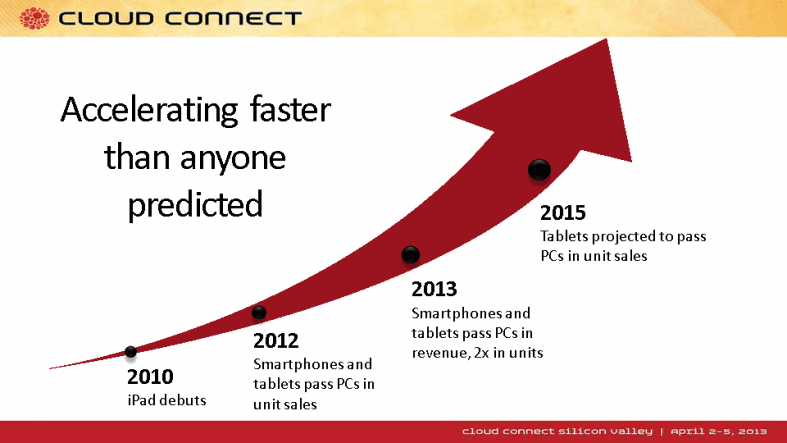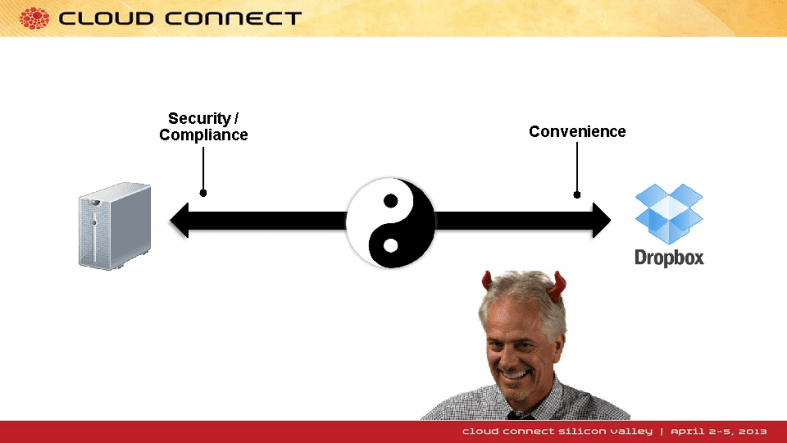Introduction:
The four-year-old Cloud Connect conference, sponsored by United Business Media, was held April 2 to 5th in Santa Clara, CA. Having attended all four Cloud Connect’s, this one was by far the most in depth and comprehensive treatment of Cloud Computing. At last, no more defining terms and debating methods of cloud computing, this year’s conference discussed how the cloud was being used now. And also how business could leverage the cloud for more effective IT operations. For example, many attendees wanted to know how to make use of a hybrid cloud as they migrate from private to public cloud or look to combine both.
We also examine how the Mobile Cloud has and will continue to change business operations. It’s a balancing act, with compromises needed between corporate compliance/security vs worker freedom/convenience.
Key Themes and Messages:
-There’s a strong focus on reinventing the data center for cloud computing, using software defined infrastructure, such as virtualized networking and storage as well as software defined networking (SDN). However, the legacy networking infrastructure from Cloud to Premises is not going away anytime soon.
-OpenStack is now an acceptable alternative to Amazon Web Services (AWS) for public clouds. There was a lot of discussion on using OpenStack for private cloud implementations as well. Openstack was initially promoted by Cloud Service Provider Rackspace, but is now endorsed by many other CSPs, including HP. There are many new and well funded OpenStack based start-ups.
-Virtual networking and SDN are being added to the growing number of OpenStack capabilities by the OpenStack Foundation (OSF). On April 4th, OSF issued its “Grizzly release,” which contains 230 new features for running production-level cloud computing. Networking has lagged servers when it comes to being managed as a virtual resource and in most enterprises, is still tied to a set of hardware resources that are hard to modify. Virtual networking and SDN aim to change that by making the network a logical rather than physical part of the IT and cloud infrastructure. OpenStack’s work on SDN “lets software change the network infrastructure for cloud computing,” according to one knowledgable conference attendee.
-Amazon’s Virtual Private Cloud (VPC) is now the defacto way of accessing AWS, replacing the public Internet (and in some cases) private lines. VPS lets the cloud user provision a logically isolated section of the AWS Cloud where resources are launched in a virtual network. The customer has complete control over the virtual networking environment, including selection of IP address range, creation of subnets, configuration of route tables and network gateways.
http://aws.amazon.com/vpc/-Big Data (analytics) and Cloud are a paradigm shift and an architectural change that involves putting data and computing power together as a massive processing unit. With the explosion in all types of information, businesses need data analytics to be competitive. Organizations need to analyze data from multiple sources and places to gain insights. That data can’t be stored in one place and can even be maintained outside the organization (such as in a private cloud).
-The reorganization of computing into larger, more demand-responsive cloud-based data centers run by Google, Amazon Web Services, Rackspace and others is part of a shift in business that replaces transaction systems with “systems of interactions,” said Cisco Systems VP of Cloud Computing Lew Tucker. “Analytics becomes business critical” because huge volumes of data will be generated by the Internet of Things (IoT), with billions of devices soon to be connected to the Internet. The billions of connected devices drive a need for cloud storage and cloud analytics. The creation of big data drives business decision-making and businesses’ need to keep employees in constant collaboration and communication, driving a need for a new style of internal networking: the software-defined network that responds more flexibly to changing conditions, Tucker said.
-Mobile Cloud is being used as more workers have mobile computing devices, especially tablets and notebooks. Organizations continue to make use of mobile apps to improve productivity and business process, according to Citrix. They deployed over 100 thrid party apps, e.g. Citrix Receiver, Adobe Reader, etc. as well as custom written apps. Packaged, deployable mobile apps stores for the enterprise are starting to emerge. Author’s Note: Mobile Cloud is covered in more detail below.
-PayPal chief information security officer Michael Barrett stated that cloud computing had changed the stakes involved in the security of computer systems. The cloud can provide the computing power to run an attack to decipher passwords. “Password hacking is now the work for script kiddies,” he warned, as opposed to a challenge for skilled hackers backed by massive compute resources.
-William Ruh, VP and global technology director at General Electric said business is moving from an analog way of operating to a digital one which will change nearly every aspect of business. Civilization is moving from the industrial revolution through the Internet revolution and into what he called “the Industrial Internet.” Machines will be connected to the Internet (IoT) and become intelligent through the software they possess that analyzes the information they’re generating. That will contrast with today’s industrial operations where machines are not intelligent and most of the data they generate “isn’t even stored,” Ruh observed. The shift will “foundationally change the way machines are built and the way data is collected on them, petabytes of information,” said Ruh. The information will be fed to the operations staffs at utility power plants and other large industrial installations, who will use it to look for efficiencies that we don’t know about today, he said.
-Case studies are beginning to emerge from a variety of users. The cloud industry has moved beyond case studies from technology innovators, such as Netflix, to rank-and-file companies that are just getting their first cloud computing systems up-and-running.
The Mobile Cloud:
Before the end of this year there will be more smart phones than PCs, and in 2015 there will be more tablets than PCs as shown in the illustration below.

Mobile and cloud are combining to change how the underlying infrastructure of business. Mobile and cloud combine to change how applications are developed, tested and distributed. Mobile changes what features and user experience exists in applications while cloud changes where data should be located and how it will be accessed. Security and management will also change as businesses embrace mobile. Applications will be device aware, location aware and network/cloud aware. But they have to be purpose built, i.e. desktop/workstation apps won’t run on mobile computing platforms- even with 4G access. And because the demand for mobile cloud resident apps is uncertain, the mobile cloud must be very flexible in scaling up or down to accomodate the actual number of users for all the mobile apps being supported.
Going forward business processes will assume a multi-device landscape, cloud connectivity. Mobile work styles are becoming the rule rather than the exception in Enterprise IT and traditional methods of securing data behind VPNs will fall short as employees demand business tools that are as easy to use and frequently updated as the ones they use at home. Unfortunately, legal and regulatory requirements for securing data are no less stringent than they were before the mobile era. There are compliance issues with laws such as HIPAA and FINRA that apply to data sync and sharing of information/digital content.
In the future, companies will rebuild transform business applications to take advantage of a range of by using contextual data from all connected devices, including location, time of day, presence and device type. Sensors in the latest devices will also also provide contextual information such as temperature, humidity, motion, and orientation. Applications based on business critical data from connected sensors will be used by many industries, with utility, oil and gas industries leading the way. Transforming business will require businesses to use the cloud and big data processing to turn mobile data into insight in real-time.
In an excellent presentation by Jesse Lipson, Citrix VP of Data Sharing, Managing Data in the Cloud said: “VPNs are going away.They are clumsy and incovenient for mobile users.” Other reasons: there’s more IP outside of the firewall, Mobile Device Management (MDM) and simpler two factor authentication are combining to alleviate the need for VPN access. Mr Lipson also sees several new trends as a result of mobile data tsunami:
-Active Directory Integration with Single Sign On (e..g. SAML 2.0)
-2 factor authentication going away; perhaps replaced by text message authentication
-Auto Log-In from mobile devices, especially smart phones
-On premises storage alive and well due to security, compliance, convenience, and ability to access existing data stores
-“Open-in…” enable another application to open in the application being run
-Device control via MDM software deployed on all enterprise owned mobile devices
-Other mobile devices, especially laptops are getting more attention for security and control
In the end, enterprise control of mobile devices, data and apps is a balancing act between corporate compliance and security vs employee convenience and productivity (see illustration below). Each organization must decide how to chose the necessary tools, methods and procesures to ensure that both objectives are met.
2013 Cloud Connect Part II is at:
http://viodi.com/2013/04/10/cloud-network-deployment-requirements-monitoring-optimization-enterprise-cloud-adoption-survey-2013-cloud-connect-part-ii/





